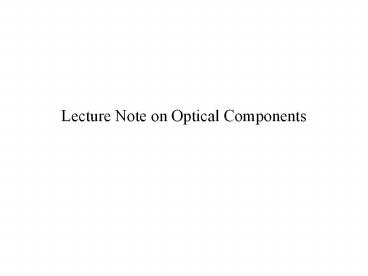Lecture Note on Optical Components - PowerPoint PPT Presentation
Title:
Lecture Note on Optical Components
Description:
Lecture Note on Optical Components – PowerPoint PPT presentation
Number of Views:252
Avg rating:3.0/5.0
Title: Lecture Note on Optical Components
1
Lecture Note on Optical Components
2
Optical Couplers
- Combines splits signals
- Light couples from one waveguide to a closely
placed waveguide because the propagation mode
overlaps the two waveguides - Wavelength independent or selective
- Fabricated using waveguides in integrated optics
- ? coupling ratio
- Power (Output1) ? Power (Input1)
- Power (Output2) (1- ?) Power (Input1)
- Power splitter if ?1/2 3-dB coupler
- Tap if ? close to 1
- ?-selective if ? depends upon ?
- Lossless combining is not possible
3
8-Port Splitter by Cascading Y-Couplers
4
8x8 Star Coupler
Power from all inputs equally split among
outputs
5
Isolators and Circulators
- Extension of coupler concept
- Non-reciprocal type will not work same way if
inputs and outputs reversed - Isolator allows transmission in one direction,
but blocks all transmission (e.g., reflection) in
the other. - Circulator is similar to isolator, but with
multiple ports.
6
Filters and Multiplexers
7
Filters
- Low insertion (input-to-output) loss
- Filter passband independent of temperature
- Flat passband
- Sharp skirts on the passband crosstalk rejection
8
Gratings
- Device using interference among optical signals
from same source, but with different relative
phase shifts (i.e. different path lengths)
9
Transmission versus Reflection Grating
10
Diffraction Gratings
11
Mux/Demux Using Cascaded Filters
- Each filter passes one ? and reflects the other
?s - Very flat top and sharp skirts
12
Amplification
13
Optical Amplifiers versus Regenerators
EDFA amplifies all ls
EDFA is a common optical amplifier.
14
OEO Regenerator
15
1R, 2R and 3R Regenerations
1R Reamplify
2R Reamplify, Reshape
3R Reamplify, Reshape, Retime
16
Regenerators versus Optical Amplifiers
- Regenerators specific to bit rate and modulation
format used optical amplifiers are insensitive. - A system with optical amplifiers can be more
easily upgraded to higher bit rate without
replacing the amplifiers. - Optical amplifiers have large gain bandwidths gt
key enabler of DWDM - Issues
- Amplifiers introduce additional noise that
accumulates. - Spectral shape of gain (flatness), output power,
transient behavior need to be carefully designed.
17
Optical Regenerator
18
Optical Receivers
19
Electronic versus Photonic Coding
20
Optical Modulation Methods
21
Eye Diagrams
22
WDM Multiplexing
- TDM 10Gb/s upper limit
- WDM Use multiple carrier frequencies to transmit
data simultaneously
B b/s
1 2 N
NB b/s
1 2 N
B b/s
...
23
Multiplexers, Filters, Routers
- Filter selects one wavelength and rejects all
others - Multiplexer combines different wavelengths
- Router exchanges wavelengths from one input to a
different output
24
Considerations in Switch
- Number of switch elements complexity of switch
- Loss uniformity different losses to different
outputs (especially for large switches) - Number of crossovers waveguide crossovers
introduce power loss and crosstalk - Blocking any unused input port can be connected
to any unused output port
25
Crossbar Switch
- Non-blocking
- Shortest path length 1
- Longest path length 2n-1
- No crossover
26
Clos Switch
27
Benes Switch
28
MEMS Mirror Switching Component
29
NxN Switching with MEMS Mirror Arrays

